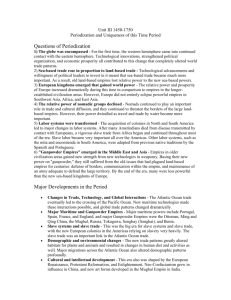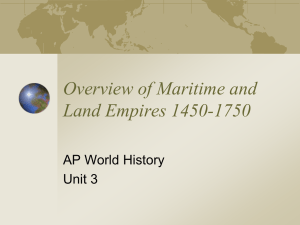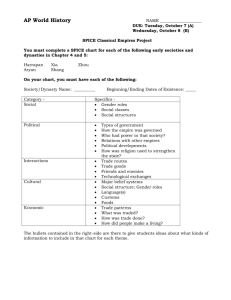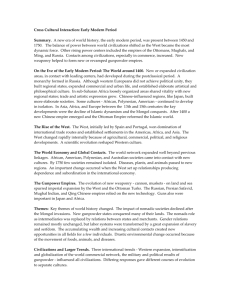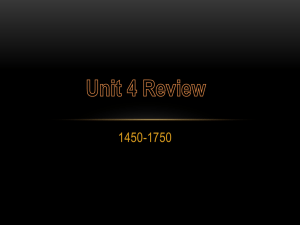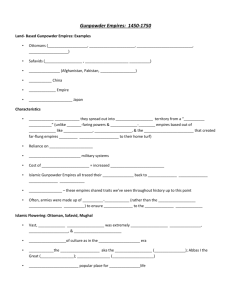1450 - 1750 CE During the time period between 1450 and 1750 CE
advertisement
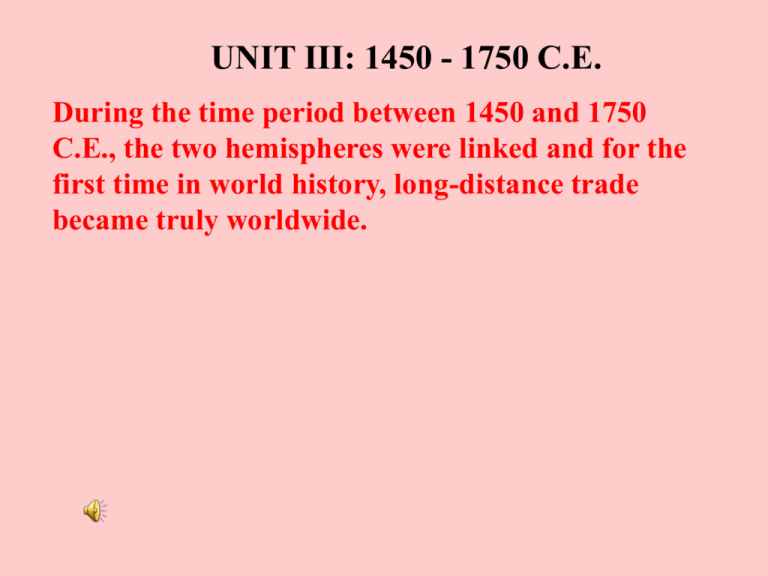
UNIT III: 1450 - 1750 C.E. During the time period between 1450 and 1750 C.E., the two hemispheres were linked and for the first time in world history, long-distance trade became truly worldwide. QUESTIONS OF PERIODIZATION This era includes only 300 years, but some profound and long-lasting changes occurred. Characteristics of the time between 1450 and 1750 include: Some slides are from historyteacher.net 1) The globe was encompassed - For the first time, the western hemisphere came into continued contact with the eastern hemisphere. Technological innovations, strengthened political organization, and economic prosperity all contributed to this change that completely altered world trade patterns. 2) Sea-based trade rose in proportion to landbased trade - Technological advancements and willingness of political leaders to invest in it meant that sea-based trade became much more important. As a result, old land-based empires lost relative power to the new sea-based powers. 3) European kingdoms emerged that gained world power - The relative power and prosperity of Europe increased dramatically during this time in comparison to empires in the longer-established civilization areas. However, Europe did not entirely eclipse powerful empires in Southwest Asia, Africa, and East Asia. 4) The relative power of nomadic groups declined Nomads continued to play an important role in trade and cultural diffusion, and they continued to threaten the borders of the large land-based empires. However, their power dwindled as travel and trade by water became more important. 5) Labor systems were transformed - The acquisition of colonies in North and South America led to major changes in labor systems. After many Amerindians died from disease transmitted by contact with Europeans, a vigorous slave trade from Africa began and continued throughout most of the era. Slave labor became very important all over the Americas. Other labor systems, such as the mita and encomienda in South America, were adapted from previous native traditions by the Spanish and Portuguese. 6) "Gunpowder Empires" emerged in the Middle East and Asia - Empires in older civilization areas gained new strength from new technologies in weaponry. Basing their new power on "gunpowder," they still suffered from the old issues that had plagued land-based empires for centuries: defense of borders, communication within the empire, and maintenance of an army adequate to defend the large territory. By the end of the era, many were less powerful than the new sea-based kingdoms of Europe. MAJOR DEVELOPMENTS - 1450-1750 C.E. •Changes in Trade, Technology, and Global Interactions - The Atlantic Ocean trade eventually led to the crossing of the Pacific Ocean. New maritime technologies made these interactions possible, and global trade patterns changed dramatically. •Major Maritime and Gunpowder Empires - Major maritime powers include Portugal, Spain, France, and England, and major Gunpowder Empires were the Ottoman, Ming and Qing China, the Mughal, Russia, Tokugawa, Songhay (Songhai), and Benin. •Slave systems and slave trade - This was the big era for slave systems and slave trade, with the new European colonies in the Americas relying on slavery very heavily. The slave trade was an important link in the Atlantic Ocean trade. •Demographic and environmental changes - The new trade patterns greatly altered habitats for plants and animals and resulted in changes in human diet and activities as well. Major migrations across the Atlantic Ocean also altered demographic patterns profoundly. •Cultural and intellectual development - This era also was shaped by the European Renaissance, Protestant Reformation, and Enlightenment. Neo-Confucianism grew in influence in China, and new art forms developed in the Mughal Empire in India. CHANGES IN TRADE, TECHNOLOGY, AND GLOBAL INTERACTIONS The 14th century brought demographic collapse to much of the eastern hemisphere with the spread of the bubonic plague. During the 15th century, as areas began to recover and rebuild their societies, they also sought to revive the network of long-distance trade that had been so devastated by the disease. The two areas that worked most actively to rebuild trade were China and Europe. MING CHINA AND THE OUTSIDE WORLD In order to restore Chinese hegemony in Asia, Emperor Yongle sponsored seven naval expeditions commanded by Admiral Zheng He, whose voyages took place between 1405 and 1433. He was a Muslim from southwestern China who rose through the administrative ranks to become a trusted advisor of the emperor Zheng He Ship Columbus EUROPEAN EXPLORATIONS Across the globe, as the mid-15th century approached, kingdoms in another area were ready to venture to the open seas with motivations very different from those of the Chinese: •Profit from commercial operations •Spread of Christianity PORTUGUESE EXPLORATION •Prince Henry the Navigator-school for navigators For most of the 16th century, the Portuguese dominated the Indian Ocean trade. How did they capture this old sea route that had been shared by Arabs, Persians, Indians, and Southeast Asians? The most important single answer is technological: they had superior weapons. Their ships were armed with cannons that they used so skillfully that their relatively small ships could overpower almost any other type of vessel. The Portuguese were intent on converting all that they met to Christianity, although they often did more harm than good, infuriating the natives by burning down mosques and/or forcing conversions Prince Henry EARLY SPANISH EXPEDITIONS THE CONQUEST OF THE AMERICAS .Europeans conquered and claimed the territories and greatly increased their prosperity and power, and Christianity spread to a whole new hemisphere. Portugal and Spain even presumed to divide the world in two by seeking the Pope's blessing on the Treaty of Tordesillas, which drew a line through north and south through the Atlantic, giving Portugal the lands east and Spain the lands west. Portugal actually lost in the long run because the lands that they "received" were already claimed by empires that did not recognize the Portuguese claims. Christófo Colón [1451-1506] Columbus Columbus’ Four Voyages The “Columbian Exchange” Squash Avocado Peppers Sweet Potatoes Turkey Pumpkin Tobacco Quinine Cocoa Pineapple Cassava POTATO Peanut TOMATO Vanilla MAIZE Syphilis Trinkets Liquor GUNS Olive COFFEE BEAN Banana Rice Onion Turnip Honeybee Barley Grape Peach SUGAR CANE Oats Citrus Fruits Pear Wheat HORSE Cattle Sheep Pigs Smallpox Flu Typhus Measles Malaria Diptheria Whooping Cough Cycle of Conquest & Colonization Explorers Official European Colony! THE WORLD ENCOMPASSED Magellan’s voyage was the first to go around the world, and it symbolized the first union of the hemispheres and the resulting worldwide contacts that have characterized world history since 1522. Other Voyages of Exploration Treasures from the Americas! In 1519 a Spanish expedition led by Hernan Cortes marched to the Aztec capital of Tenochtitlan and defeated the great empire with only a few hundred soldiers Shortly after the Spanish arrived in Tenochtitlan, a smallpox epidemic broke out in the city that killed or incapacitated the Aztec army. A few years later Francisco Pizarro attacked and defeated the Inca. With the fall of those two empires the Spanish gained virtual control of Mesoamerica and South America, with the exception of Brazil, which fell on the Portuguese side of the line set by the Treaty of Tordesillas. Cortez THE FRENCH AND ENGLISH IN NORTH AMERICA The French and English did not arrive in the Americas until the 17th century, but when they did, they claimed much of North America in areas that the Spanish did not go. THE GREAT CIRCUIT AND THE COLUMBIAN EXCHANGE •Europe to the Americas - horses, cows, pigs, wheat, barley, sugar cane, melons, grapes •Africa (includes Asian products) to the Americas bananas, coconut palms, coffee, sugar cane, goats, chickens •The Americas to Europe and Africa - corn, potatoes, tomatoes, sweet potatoes, pumpkins, squash, beans, pineapples, peppers, tobacco, chocolate TECHNOLOGY AND THE MARITIME REVOLUTION •Guns and gunpowder •New ship technology •The compass - This technology was copied from the Arabs, who had earlier learned it from the Chinese. The compass pointed north, an important indication for ships traveling east to west. •The astrolabe - An invention of the Arabs, the astrolabe allowed a sea captain to tell how far north or south his ship was from the equator •Cartography - European explorers recorded the new territories on maps, and the art of accurate mapmaking progressed significantly. Astrolabe MAJOR EMPIRES: 1450-1750 Political developments during this era saw the greatest changes in European governments, and by extension the government structures that they set up in the New World. New Gunpowder Empires emerged in other parts of the world, and in most cases, their rulers ruled absolutely, as did most of the rulers in Europe. THE GUNPOWDER EMPIRES In contrast to the sea-based empires developing in Europe, landbased empires remained the dominant political form in other parts of the eastern hemisphere. The era between 1450 and 1750 saw the appearance of several land-based empires who built their power on the use of gunpowder: the Ottomans and the Safavids in Southwest Asia, the Mughals in India, the Ming and Qing in China, and the new Russian Empire. All had huge land armies armed with guns. These empires developed relatively independently from western influence, and to some extent they counterbalanced the growth of European power and colonization. An important consequence of the appearance of the Gunpowder Empires was their conquest of most nomadic groups. Since the nomads had less access to guns, the empires were finally able to conquer and subjugate them. In many areas direct relations among states or merchant groups replaced nomadic intermediaries for international contact. For example, European kings invited diplomats from other countries to join their courts, and China also received foreign representatives THE MUSLIM EMPIRES In the previous era, the political power of Muslim lands had been crushed by Mongol invasions in the 13th century and those of Timur, a central Asian of Mongol descent, in the 14th century. Three new empires ; the Ottoman, the Safavid, and the Mughal - rose between 1450 and 1750, and collectively they supported a new flowering of Islamic civilization. However, competition between them also led to important political divisions and military clashes. All three originated in the Turkic nomadic cultures of the central Asian steppe, and they all had absolute monarchs who modeled their courts on those of earlier Islamic dynasties. Mughal minature Taj Mahal AFRICAN KINGDOMS In 1450 Africa was a diverse continent with a blend of large civilizations, city-states, rural villages, and hunter and gatherer societies. Many people in the north, Subsaharan and eastern coastline areas were Muslim, but many native religions remained quite strong The largest and most organized empire of Africa from the middle of the 15th century until the late 16th century was Songhay (Songhai) in northwest Africa in areas that had been controlled by the earlier Kingdom of Mali. The 16th century also saw the destruction of most of the Swahili city-states. Vasco da Gama had noticed them when he passed through on his way to India, and within a few years the Portuguese had aimed their cannons at all the cities, and either captured them or burned them to the ground. The fate of the Kingdom of Kongo was an early sign of what contact with Europe was to bring to Africa. Kongo was on the Atlantic Ocean in central Africa, that developed into a centralized state during the 14th century. The Portuguese set up a trading relationship with them in the late 15th century and converted the Kongo kings to Christianity. From the beginning, the Portugues traded textiles, weapons, advisors, and craftsmen for gold, silver, ivory and especially slaves THE SLAVE TRADE AND SLAVE SYSTEMS THE AFRICAN SLAVE TRADE Before the Atlantic slave trade began, slavery took many forms in Africa, ranging from peasants trying to work off debts to those that were treated as "chattel," or property. The Atlantic trade emphasized the latter, and profits from the trade allowed slaveholders both in Africa and the Americas to intensify the level of exploitation of labor. African slaves were traded to two areas of the world: the Western Hemisphere and Islamic lands in the Middle East and India Trans-Atlantic Slave Trade The Slave Trade 1. Existed in Africa before the coming of the Europeans. 2. Portuguese replaced European slaves with Africans. Sugar cane & sugar plantations. First boatload of African slaves brought by the Spanish in 1518. 275,000 enslaved Africans exported to other countries. 3. Between 16c & 19c, about 10 million Africans shipped to the Americas. Slave Ship TRADE TO MUSLIM LANDS Fewer slaves crossed the Sahara than crossed the Atlantic, but the numbers were substantial. Whereas most slaves that went to the Americas were male, most of those destined for the Middle East and India were female. These women either became a part of a wealthy individual's harem, or collection of wives and concubines that filled his household. The wives were not slaves, and their children had higher status than those of the concubines. The African women were almost always granted the lower status as concubines. Other slaves in the Islamic lands were males who were often bought to fight in the large Gunpowder Empire armies. TRADE TO THE AMERICAS The major reason that slave labor was practical in the Americas was that so many of the Amerindians who probably would have done the work had died. The economic challenge was to get workers to the New World in as cost effective way as possible. The Spanish and Portuguese expeditions were government ventures, but the success of the Atlantic economy during the 17th and 18th centuries was based on private enterprise. The economic system of mercantilism was developed most effectively by the British and the Dutch, with private companies under charter from the governments carrying out the trade. Mercantilism's main goal was to benefit the mother country by trading goods to accumulate precious metals, and thus enriching the country. The African slave trade was an important piece of mercantile trade. Impact of European Expansion 1. Native populations ravaged by disease. 2. Influx of gold, and especially silver, into Europe created an inflationary economic climate. 3. New products introduced across the continents [“Columbian Exchange”]. 4. Deepened colonial rivalries. LABOR SYSTEMS IN THE AMERICAS The Spanish were most interested in finding gold and silver in the Americas, and so early on they began mining for it. In areas where no precious metals existed, they set up plantations to raise crops from bananas to sugar cane. They first tried these labor systems •Mita - The Inca had made extensive use of the mita system, a sort of labor tax to support elites and the elderly. Generally, an adult male had to spend 1/7 of his time working for the Inca, a few months at a time. When his obligation to the state was complete, he would return home until his service time came up again. The Spanish adopted this system, particularly for their silver mines in Bolivia and surrounding areas. The problem was that so many natives died, that the Spanish kept having to increase the time spent in the mines that it became impractical. Finally, the work in the mines was so grueling that no Indians were left to do the work. •Encomienda - This system was used primarily for agricultural work. Natives in an area were placed under the authority of encomenderos, or Spanish bosses, who could extract labor and tribute according to the needs of the area. Again, this system only lasted during the 16th century because so many natives died. CULTURAL AND INTELLECTUAL DEVELOPMENTS The Renaissance, or "rebirth" was characterized by an attempt to revive the values of the classical civilizations of the Mediterranean, Greece and Rome 1. Realism & Expression Expulsion from the Garden Masaccio 1427 First nudes since classical times. 2. Perspective The Trinity Perspective! Perspective! Perspective! Perspective! Perspective! Perspective! Masaccio 1427 Perspective! First use of linear perspective! What you are, I once was; what I am, you will become. 3. Classicism Greco-Roman influence. Secularism. Humanism. Individualism free standing figures. Symmetry/Balance The “Classical Pose” Medici “Venus” (1c) 4. Empasis on Individualism Batista Sforza & Federico de Montefeltre: The Duke & Dutchess of Urbino Piero della Francesca, 1465-1466. 5. Geometrical Arrangement of Figures The Dreyfus Madonna with the Pomegranate Leonardo da Vinci 1469 The figure as architecture! 6. Light & Shadowing/Softening Edges Sfumato Chiaroscuro Vermeer –Girl with the pearl earring THE SCIENTIFIC REVOLUTION The revival of interest in Greek and Roman influences also stimulated developments in math and science. The mathematical traditions that governed the conception of the universe were based in Greek mathematics that had been preserved and built upon by scientists in Muslim lands, such as Nasir al-Din in the 13th century. Copernicus- Heliocentric Theory Galileo on trial THE PROTESTANT REFORMATION For example, in 1519, when Luther openly challenged the religious authority of the church, the Pope was conducting an indulgence campaign to raise money for a new basilica for St. Peter's Church in Rome. Tetzel was the priest collecting indulgences in Wittenberg, who so enraged Luther with his blatant selling of indulgences for promises of salvation that he wrote and openly displayed the 95 Theses, which listed 95 problems with church practices. With this action, Luther did what no priest had dared to do before ; openly defy the authority of the church Luther and 95 theses •His writings were widely accepted in Germany, where Protestantism, as the protest movement came to be called, took firm root. •Other Protestant groups sprang up in France, and from their found new vitality in Geneva, Switzerland, where John Calvin started yet another branch of Protestantism called Calvinism. •Calvinism was carried to Scotland by one of Calvin's admirers, John Knox, and from there it made its way into England. •Another blow to the church came when King Henry VIII of England separated religious institutions in his kingdom from the church when the Pope refused to grant him an annulment from his first wife, Catherine of Aragon. THE IMPORTANCE OF THE PRINTING PRESS Johannes Gutenberg, a printer from Mainz Germany, contributed greatly to the rapid spread of Protestantism. He died in 1468, many years before the Reformation began, but without his construction of a workable printing press around 1450, Luther's word almost certainly never would have gotten out. In 1454 he printed his famous Gutenberg Bible with moveable type, and the book inspired early Renaissance writers, such as Erasmus, to use the technology to print their own works. 1450-printing press PATRONAGE IN THE ISLAMIC EMPIRES Just wealth in the Italian city-states prompted patronage of the arts, so it did in the Islamic Empires as well. The emperors competed to attract the best scholars, literary writers, artists, and architects to their courts. The Ottoman sultans built beautiful palaces and mosques, with the most famous religious complex built by Suleyman the Magnificent called Suleymaniye, a blend of Islamic and Byzantine architectural features. Suleiman the Magnificent: (1520-1566) Suleiman’s Signature Qur’an Page: Arabic Calligraphy Blue Mosque Janissaries Battle of Lepanto (1571) The Ottoman Empire During the 16c By 1750 the world was a much different one than had existed in 1450. This era saw the rise of Europe, though scholars debate just how much power Europeans actually had in the world economy. They dominated the New World, which was connected by regular, sustained contact to the eastern hemisphere during this time. They also controlled much of the African slave trade, but it is important to note that no European had ventured far into the interior of the continent by 1750. They were still dependent on African kingdoms to bring the slaves to the trading posts, and Europeans had not set up significant colonies in Africa, except at the very southern tip, Capetown near the Cape of Good Hope. This situation would change dramatically during the following era. Great empires continued to form in East Asia, the Middle East, and India, as the technological invention of gunpowder allowed them to conquer the nomadic groups that had challenged their authority for centuries. However, land-based empires clearly lost power in proportion to sea-faring powers, as world trade routes connected the western hemisphere to the east. These increased contacts were to have important consequences for people all over the world in the period from 1750-1914.

